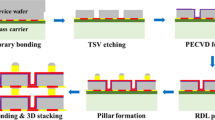Abstract
This paper describes polymer cap 0-level packaging of RF devices, which is based on successive wafer scale bonding and debonding techniques. Pre-fabricated benzocyclobutene (BCB) membranes on a carrier wafer were directly transferred onto a target substrate by wafer scale bonding process. Using an anti-adhesion layer of hydrophobic octadecyltrichlorosilane (OTS) self-assembled monolayer (SAM), the carrier wafer was mechanically detached from the membranes without any aggressive etching process. As a result, BCB packaging caps in various sizes have been successfully fabricated on a 3 inch Si substrate. BCB cap deformation by thermal residual stress was investigated using ANSYS simulation and the measured results were in good agreement with the simulated ones. Si3N4 film was deposited on the caps for hermetic sealing and the hermeticity was evaluated by N2 leak test. Finally, the suitability of BCB caps in RF applications was assessed by Sparameter measurement of gold coplanar waveguide (CPW) transmission lines. The insertion loss change by BCB packaging was negligible and the return loss was better than 20 dB from DC to 50 GHz.
Similar content being viewed by others
Abbreviations
- ɛr :
-
relative permittivity
- σ:
-
electrical conductivity
- Z:
-
electrical impedance
- θc :
-
water contact angle
- γ:
-
surface energy
References
Malshe, A. P., O’Neal, C., Singh, S. B., Brown, W. D., Eaton, W. P., and Miller, W. M., “Challenges in the Packaging of MEMS,” International Journal of Microcircuits and Electronic Packaging, Vol. 22, No. 3, pp. 233–241, 1999.
Seok, S., Rolland, N., and Rolland, P. A., “Packaging methodology for RF devices using a BCB membrane transfer technique,” Journal of Micromechanics and Microengineering, Vol. 16, No. 11, Paper No. 2384, 2006.
Seok, S., Rolland, N., and Rolland, P. A., “Mechanical and Electrical Characterization of Benzocyclobutene Membrane Packaging,” 57th Electronic Components and Technology Conference, pp. 1685–1689, 2007.
Murillo, G., Davis, Z. J., Keller, S., Abadal, G., Agusti, J., Cagliani, A., Noeth, N., Boisen, A., and Barniol, N., “Novel SU-8 based vacuum wafer-level packaging for MEMS devices,” Microelectronic Engineering, Vol. 87, No. 5–8, pp. 1173–1176, 2010.
Dow, “CYCLOTENE 4000 Series Advanced Electronic Resins (Photo BCB),” http://www.dow.com/cyclotene/docs/cyclotene_4000_puddle_dev.pdf
Seok, S., Rolland, N., and Rolland, P. A., “Design, Fabrication, and Measurement of Benzocyclobutene Polymer Zero-Level Packaging for Millimeter-Wave Applications,” IEEE Transactions on Microwave Theory and Techniques, Vol. 55, No. 5, pp. 1040–1045, 2007.
Kim, J. G., Seok, S., Rolland, N., and Rolland, P. A., “A Novel Wafer Level Bonding/Debonding Technique Using an Anti-Adhesion Layer for Polymer-Based Zero-Level Packaging of RF Device,” The 60th Electronic Components and Technology Conference, 2010.
De Gennes, P. G., “Wetting: statics and dynamics,” Reviews of Modern Physics, Vol. 57, No. 3, pp. 827–863, 1985.
Stoney, G. G., “The Tension of Metallic Films Deposited by Electrolysis,” Proceedings of the Royal Society A: Mathematical, Physical and Engineering Sciences, Vol. 82, No. 553, pp. 172–175, 1909.
Brantley, W. A., “Calculated elastic constants for stress problems associated with semiconductor devices,” Journal of Applied Physics, Vol. 44, No. 1, pp. 534–535, 1973.
Okada, Y. and Tokumaru, Y., “Precise determination of lattice parameter and thermal expansion coefficient of silicon between 300 and 1500 K,” Journal of Applied Physics, Vol. 56, No. 2, pp. 314–320, 1984.
Shames, I. H., “Introduction to solid mechanics, 2nd Ed.,” Prentice Hall, pp. 243–273, 1989.
Santagata, F., Zaal, J. J. M., Huerta, V. G., Mele, L., Creemer, J. F., and Sarro, P. M., “Mechanical Design and Characterization for MEMS Thin-Film Packaging,” Journal of Microelectromechanical Systems, Vol. 21, No. 1, pp. 100–109, 2012.
Zhou, W., Zhang, J., Liu, Y., Li, X., Niu, X., Song, Z., Min, G., Wan, Y., Shi, L., and Feng, S., “Characterization of antiadhesive self-assembled monolayer for nanoimprint lithography,” Applied Surface Science, Vol. 255, No. 5, pp. 2885–2889, 2008.
Author information
Authors and Affiliations
Corresponding author
Rights and permissions
About this article
Cite this article
Kim, JG., Seok, S., Rolland, N. et al. Polymer-based zero-level packaging technology for high frequency RF applications by wafer bonding/debonding technique using an anti-adhesion layer. Int. J. Precis. Eng. Manuf. 13, 1861–1867 (2012). https://doi.org/10.1007/s12541-012-0244-7
Received:
Accepted:
Published:
Issue Date:
DOI: https://doi.org/10.1007/s12541-012-0244-7




